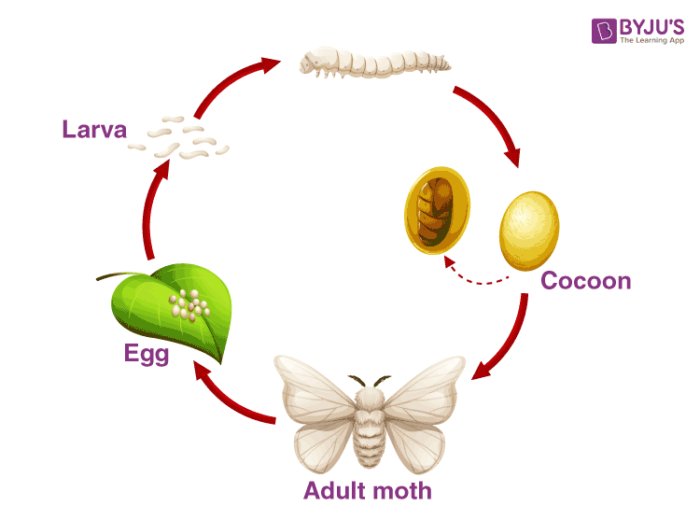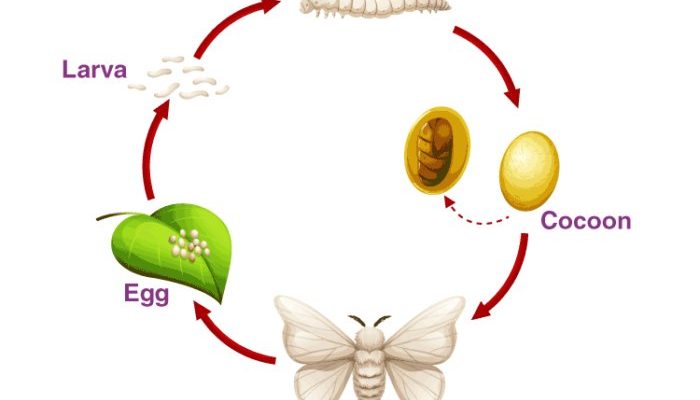
Silkworms, scientifically known as *Bombyx mori*, have a unique journey full of changes and growth. You might think they’re just simple insects, but their life cycle is a complex and amazing process, influenced by factors like temperature and humidity. Let’s unravel this lifecycle, step by step, and discover the magic behind silk production.
Stage 1: The Silkworm Egg
The lifecycle of a silkworm begins with the egg. These tiny, round eggs are about the size of a pinhead and can be pale yellow or white. A female moth lays hundreds of these eggs, usually between 300 to 400 at a time! Think about it—each egg contains the potential for a new life.
After being laid, the eggs need the right conditions to hatch. They prefer a temperature of around 25 degrees Celsius (77 degrees Fahrenheit) and a humid environment. It might take about 10 days for the eggs to hatch, depending on the conditions. During this time, you could say the eggs are getting cozy, preparing to burst into life!
Stage 2: The Larval Stage
Once the eggs hatch, they reveal tiny larvae, which we commonly refer to as silkworms. At this point, these little creatures are hungry and need to eat—A LOT! They primarily feed on mulberry leaves, their favorite snack. You might be surprised to learn that a silkworm can grow several thousand times its weight during this stage.
This larval stage lasts about 4 to 6 weeks. During this time, the silkworm goes through several phases called instars. Each time it sheds its skin to make room for its growing body is called molting. It’s like a subpar superhero—shedding its old self to become bigger and stronger.
Stage 3: Preparing for Transformation
After feasting and growing, the silkworm reaches a point where it’s ready to transform, entering the pupal stage. But first, they need to get organized! The silkworm starts to find a safe spot, often spinning a cocoon to protect itself. Using special glands, it secretes a fluid that hardens into silk threads.
Building this cocoon can take about 2 to 3 days, where the silkworm wraps itself tightly in a beautiful silk covering. Imagine being wrapped in a cozy blanket—only it’s made of silk! This cocoon is not just for show; it provides a safe space for the silkworm to undergo one of nature’s most incredible transformations.
Stage 4: The Pupa
Now that the silkworm is safely tucked away in its cocoon, it enters the pupal stage. This is where the real magic happens. Inside the cocoon, the silkworm undergoes a metamorphosis, changing its form from a caterpillar into a moth.
During this phase, the pupa is completely still, relying on stored energy from its previous life stage. It might sound like a long nap, but really it’s a busy time for the silkworm. The pupa can last anywhere from 10 to 14 days, depending on environmental factors like temperature and humidity. It’s like a caterpillar’s version of a spa retreat, preparing to emerge as a stunning moth.
Stage 5: The Adult Moth
Finally, we arrive at the last stage—the adult moth! Once the transformation is complete, the moth will break free from its cocoon. It usually emerges with crumpled wings and takes some time to inflate them fully. It’s quite the sight! Once fully developed, the moth can’t eat; its only job is to mate and lay eggs, completing the lifecycle.
Adult moths are generally white or cream, reaching about 10 centimeters (4 inches) across. They have short lifespans, usually around 1 to 2 weeks. Despite their brief time on Earth, they play a crucial role in the continuance of their species. The cycle will begin anew as female moths lay eggs, starting the process all over again.
Understanding the Importance of the Silkworm Lifecycle
So, why does the silkworm lifecycle matter? For starters, it’s a crucial part of silk production. The silk harvested from cocoons has been prized for centuries in fashion and textiles. Understanding this lifecycle also highlights the incredible complexity of nature, showing just how much goes into creating something as simple as a piece of silk fabric.
Additionally, the silkworm has been a staple in several ecosystems, serving as both a food source for various predators and a subject of study in genetics and agriculture. By appreciating the lifecycle of the silkworm, we can better understand the interconnectedness of various species and their environments.
In conclusion, the journey of the silkworm—from a tiny egg to a magnificent moth—is a remarkable process that showcases the beauty of transformation in nature. Each stage is essential in fostering the next, ultimately contributing to the rich world of silk that we enjoy today. So next time you wrap yourself in a silk scarf or shirt, remember the incredible journey that little silkworm undertook to bring that fabric to life.

